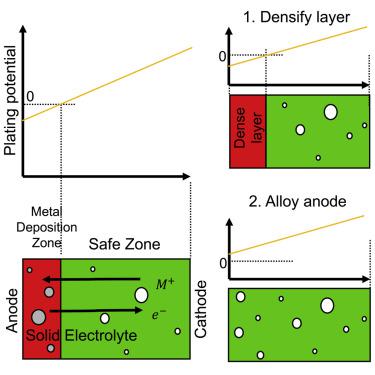Matter ( IF 17.3 ) Pub Date : 2021-09-08 , DOI: 10.1016/j.matt.2021.08.004 Qingsong Tu 1, 2 , Tan Shi 1 , Srinath Chakravarthy 3 , Gerbrand Ceder 1, 2

|
Metal penetration into a solid electrolyte (SE) is one of the critical problems impeding the practical application of solid-state batteries. In this study, we investigate the conditions under which electronic conductivity of the SE can lead to metal deposition and fracture within the SE. Three different stages for void filling (metal plating initiation, metal growth, and metal compression) in the SE are identified. We show that a micron-size isolated void in the SE near the anode can be quickly filled in by metal and fractured when the developed pressure in the void grows larger than the maximum pressure the SE material can sustain. We find that the anode voltage and applied current density play a significant role in determining the vulnerability to metal deposition. We discuss several strategies to prevent electronic conductivity-driven metal propagation in electrolytes that are not fully dense, including the densified layers between the anode and SE.
中文翻译:

了解由于混合离子电子传导导致的固体电解质中的金属传播
金属渗透到固体电解质(SE)中是阻碍固态电池实际应用的关键问题之一。在这项研究中,我们调查了 SE 的电子电导率会导致 SE 内金属沉积和断裂的条件。确定了 SE 中空隙填充的三个不同阶段(金属电镀开始、金属生长和金属压缩)。我们表明,当空隙中产生的压力大于 SE 材料可以承受的最大压力时,阳极附近 SE 中的微米级隔离空隙可以被金属快速填充并破裂。我们发现阳极电压和施加的电流密度在确定金属沉积的脆弱性方面起着重要作用。











































 京公网安备 11010802027423号
京公网安备 11010802027423号